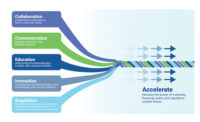Primer Debuts on Life-Cycle Assessments of Embodied Carbon in Buildings

The different stages of the carbon cycle in the built environment, according to a new practice guide on the life-cycle assessment of embodied carbon in buildings.
Graphic courtesy of the Carbon Leadership Forum
A recently released primer for the use of a life-cycle assessment approach to analyze the environmental impacts of buildings is considered a small but necessary step toward the ambitious goal of getting to net-zero embodied carbon and operational greenhouse gas emissions in the construction, operation and decommissioning of buildings. The LCA guide comes after the release of the first-of-its-kind benchmarking database of embodied carbon in existing buildings. And another first—a tool to calculate embodied carbon in construction—is on the horizon.
"Architects and engineers are starting to use LCAs in practice because of growing awareness of sustainability and because they can get LEED points," says Kate Simonen, director of the Carbon Leadership Forum at the University of Washington, which published the 33-page primer, called Life-Cycle Assessment of Buildings: A Practice Guide, late last month.
LCA for construction is the method used to quantify carbon dioxide emitted during the extraction, manufacture, transport and construction of building materials, together with end-of-life emissions. The publication, which also includes LCA guidance for operational carbon emissions, is intended to help building professionals understand why and how to use LCA in their work. The goal is to standardize what is an emerging practice, says Simonen, the guide's principal investigator. Available LCA tools do not calculate things the same way, she adds.
"There's a greater interest in LCAs than in the past but few owners have done LCAs because not enough has been done for owners to be sure of the cost or the benefit," says Stacy Smedley, director of sustainability for Skanska USA Building Inc.
Smedley is the industry champion for the guide, which is part of a research project, called LCA for Low Carbon Construction, that also produced the benchmarking database. The $155,000 LCA project is funded by $100,000 from the Charles Pankow Foundation, $45,000 from Skanska and $10,000 from the Oregon Dept. of Environmental Quality. All the data for the LCA project is open source, and all the material is available free of charge.
For Beginners
The primer is mostly intended for LCA beginners. It defines the different carbon cycles in the built environment, including the product stage, the use stage, the end-of-life stage and the so-called beyond-system-boundary stage, which includes reuse, recovery and recycling potential. The guide then lists the steps that users should follow when performing an LCA.
The publication also presents the five most commonly tracked environmental impact categories—potential for global warming, ozone depletion, acidification, smog formation and eutrophication or the excessive richness of nutrients in a lake or other body of water, frequently due to runoff. Finally, the guide has a supplemental web page containing online resources. These include technical guidance documents for LCA tool developers and experts, and a list of LCA resources.
The embodied carbon benchmark study, released early last year by the Carbon Leadership Forum, is a digital database of the embodied carbon of more than 1,000 buildings. The main purpose of the project was to establish reasonable estimates of the typical embodied carbon of building construction and characterize the level and sources of uncertainty in the current knowledge. The study was an important precursor of the guide, says Simonen.
"The guide is important but the next step is to offer tools so that teams can take action," says Smedley.
Skanska is working on the first tool, called the Embodied Carbon in Construction Calculator, which also will be free to all users. The contractor is purposely carving out embodied carbon in materials in construction—from the cradle to the gate—because it is manageable, says Smedley.
Skanska is applying the calculator on a "real" multibuilding project, but Smedley declines to name the client. "It's the first time we are looking at reductions during design," she says.
To date, Skanska and its unnamed client have funded the calculator project, but Smedley hopes to get other funding to finish the tool. "The concrete component is complete but we need funds for steel, glazing, aluminum" and other materials, Smedley says.
The aim is to have all the material categories functioning in September so that the calculator can be piloted on the multibuilding project.






